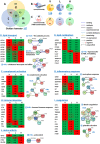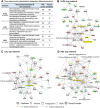Lipoprotein proteome profile: novel insight into hyperlipidemia
- PMID: 33931962
- PMCID: PMC8032137
- DOI: 10.1002/ctm2.361
Lipoprotein proteome profile: novel insight into hyperlipidemia
Conflict of interest statement
The authors declare no competing financial interest.
Figures


Similar articles
-
Advances in lipoprotein research. Biochemical and clinical aspects.Arch Inst Cardiol Mex. 1973 May-Jun;43(3):474-87. Arch Inst Cardiol Mex. 1973. PMID: 4374142 No abstract available.
-
The binding of 2,3,7,8-tetrachlorodibenzodioxin to plasma lipoproteins may delay toxicity in experimental hyperlipidemia.Chem Biol Interact. 1983 Aug 1;45(3):393-9. doi: 10.1016/0009-2797(83)90086-8. Chem Biol Interact. 1983. PMID: 6883580 No abstract available.
-
Studies on serum lipoproteins of rats developing spontaneous hyperlipidemia.Artery. 1981;9(6):456-76. Artery. 1981. PMID: 7337554
-
[Structure and function of plasma lipoproteins].Acta Med Austriaca Suppl. 1977;(4):70-3. Acta Med Austriaca Suppl. 1977. PMID: 199020 Review. German. No abstract available.
-
Treatment of hyperlipidemia.N Engl J Med. 1974 Jun 6;290(23):1295-301. doi: 10.1056/NEJM197406062902306. N Engl J Med. 1974. PMID: 4363888 Review. No abstract available.
Cited by
-
Ionizable drug delivery systems for efficient and selective gene therapy.Mil Med Res. 2023 Feb 27;10(1):9. doi: 10.1186/s40779-023-00445-z. Mil Med Res. 2023. PMID: 36843103 Free PMC article. Review.
-
Identification of oxylipins and lipid mediators in pulmonary embolism.Lipids Health Dis. 2024 Oct 9;23(1):330. doi: 10.1186/s12944-024-02315-6. Lipids Health Dis. 2024. PMID: 39385249 Free PMC article.
-
Clot or Not? Reviewing the Reciprocal Regulation Between Lipids and Blood Clotting.Arterioscler Thromb Vasc Biol. 2024 Mar;44(3):533-544. doi: 10.1161/ATVBAHA.123.318286. Epub 2024 Jan 18. Arterioscler Thromb Vasc Biol. 2024. PMID: 38235555 Review.
-
The Hypolipidemic Effect of Hawthorn Leaf Flavonoids through Modulating Lipid Metabolism and Gut Microbiota in Hyperlipidemic Rats.Evid Based Complement Alternat Med. 2022 Nov 15;2022:3033311. doi: 10.1155/2022/3033311. eCollection 2022. Evid Based Complement Alternat Med. 2022. PMID: 36425260 Free PMC article.
References
-
- van Himbergen TM, van Tits LJH, ter Avest E, et al. Paraoxonase (PON1) is associated with familial combined hyperlipidemia. Atherosclerosis. 2008;199:87–94. - PubMed
-
- Rader DJ, Hovingh GK. HDL and cardiovascular disease. Lancet. 2014;384(9943):618–625. - PubMed
-
- Godzien J, Ciborowski M, Armitage EG, et al. A single in‐vial dual extraction strategy for the simultaneous lipidomics and proteomics analysis of HDL and LDL fractions. J Proteome Res. 2016;15(6):1762–1775. - PubMed
-
- Dashty M, Motazacker MM, Levels J, et al. Proteome of human plasma very low‐density lipoprotein and low‐density lipoprotein exhibits a link with coagulation and lipid metabolism. Thromb Haemost. 2014;111(3):518–530. - PubMed
Publication types
MeSH terms
Substances
LinkOut - more resources
Full Text Sources
Other Literature Sources
